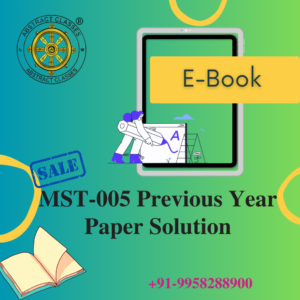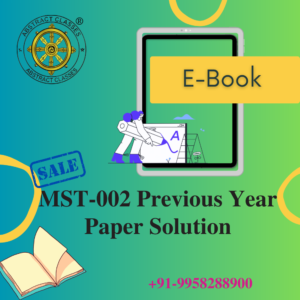₹1,095.00
Share with your Friends
UPSC Maths Optional Question Papers
| 21 | 16 | 25 | 13 | 11 | |
| 17 | 18 | 14 | 23 | 13 | |
| 32 | 27 | 18 | 41 | 19 | |
| 6 | 10 | 12 | 15 | 43 |
| 2 | 4 | 6 | 8 | 10 | 12 | 14 | 16 | 18 | 20 | |
| 16 | 40 | 32 | 8 | 0 |
बशर्ते कि
Minimize
subject to
अधिकतमीकरण कीजिए
बशर्ते कि
Maximize
subject to
(ii) (\rceil
(ii) Obtain the principal conjunctive normal form of
(\rceil
| 1 | 1 | 1 | 1 |
| 1 | 1 | 0 | 1 |
| 1 | 0 | 1 | 1 |
| 1 | 0 | 0 | 0 |
| 0 | 1 | 1 | 1 |
| 0 | 1 | 0 | 0 |
| 0 | 0 | 1 | 0 |
| 0 | 0 | 0 | 0 |
| 1 | 1 | 1 | 1 |
| 1 | 1 | 0 | 1 |
| 1 | 0 | 1 | 1 |
| 1 | 0 | 0 | 0 |
| 0 | 1 | 1 | 1 |
| 0 | 1 | 0 | 0 |
| 0 | 0 | 1 | 0 |
| 0 | 0 | 0 | 0 |
(c) दर्शाइए कि
Show that
The width of all curtains is same as that of available pieces. Form a linear programming problem in standard form that decides the number of pieces cut in different ways so that the total trim loss is minimum. Also give a basic feasible solution to it.
न्यूनतमीकरण कीजिए
बशर्ते कि
Minimize
subject to
तब दर्शाइए कि
then show that
तब विश्लेषिक फलन
then find an analytic function
का एक मूल अन्तराल
has one root in the interval
के हल के लिए गाउस-सीडल पुनरावर्ती क्रिया-विधि निर्धारित कीजिए तथा आरंभिक सदिश
which is exact for polynomials of highest possible degree. Then use the formula to evaluate
डोरी में
न्यूनतम
is the error function and min.
- (c)
(m)/(2) \frac{m}{2} (+-a,0) (\pm a, 0) x^(2)+y^(2)=a^(2) x^2+y^2=a^2 y y y y
और
Maximize
subject to
Moreover
न्यूनतमीकरण कीजिए
बशर्ते कि
Minimize
subject to
अधिकतमीकरण कीजिए
बशर्ते कि
प्रति समस्या का उपयोग करते हुए, सत्यापित करें कि बुनियादी समाधान
Maximize
subject to
Use the dual problem to verify that the basic solution
(i) पूर्णांक 524 को द्विआधारी पद्धति में ।
(ii)
(iii) दशमलव 5280 को षड्दशमलव पद्धति में ।
(iv) अज्ञात संख्या ज्ञात कीजिए
(i) Integer 524 in binary system.
(ii)
(iii) decimal number 5280 to hexadecimal system.
(iv) Find the unknown number
- (c) एक त्रिज्या
a a k k b b (b-a)(1+(k^(2))/(a^(2))) (b-a)\left(1+\frac{k^2}{a^2}\right)
- (a) हेमिल्टन समीकरण का उपयोग करते हुए, एक गोला, जो कि एक खुरदरी आनत तल (inclined plane) पर नीचे की ओर लुढ़क रहा है, का त्वरण ज्ञात करें, यदि
x x
(ii) व्यंजक न्यूनतम करें ।
(iii) समानीत व्यंजक के लिये तार्किक आरेख खींचें ।
(ii) Minimize the expression.
(iii) Draw the logical diagram for the reduced expression.
कंपन करता है.। अगर अनंत पर दबाव
और ये भी दर्शाएं कि तरल गति किसी भी बिन्दु पर
Show also that the fluid speed at any point is
1.(a) मान लीजिए
(i) absolutely convergent and (ii) conditionally convergent.
न्यूनतमीकरण कीजिए
बशाते कि
Minimize
subject to
(i)
(ii)
दर्शाइए कि सभी
(i)
(ii)
Show that
(i)
(ii)
(iii)
(i)
(ii)
(iii)
सिम्पसन के
| समय (मिनट) Time (Minutes) | 2 | 4 | 6 | 8 | 10 | 12 | 14 | 16 | 18 | 20 |
| रफ़तार (किमी /घं) Speed | 10 | 18 | 25 | 29 | 32 | 20 | 11 | 5 | 2 |
में से गुजरने वाले समाकल पृष्ठ को भी ज्ञात कीजिए।
(i)
(ii)
(iii)
(iv)
(i)
(ii)
(iii)
(iv)
जहाँ
UPSC Maths Optional Solved Papers (2018-2022)
Introduction
- Define a bijective function f : G → G ′f : G → G ′ f:G rarrG^(‘)f: G \to G’f:G→G′.
- Show that ff fff preserves the group operation, i.e., f ( a ⋅ b ) = f ( a ) + 4 f ( b )f ( a ⋅ b ) = f ( a ) + 4 f ( b ) f(a*b)=f(a)+_(4)f(b)f(a \cdot b) = f(a) +_4 f(b)f(a⋅b)=f(a)+4f(b) for all a , b ∈ Ga , b ∈ G a,b in Ga, b \in Ga,b∈G.
Work/Calculations
Step 1: Define a Bijective Function f : G → G ′f : G → G ′ f:G rarrG^(‘)f: G \to G’f:G→G′
Step 2: Show that ff fff Preserves the Group Operation
- a = 1 , b = 1a = 1 , b = 1 a=1,b=1a = 1, b = 1a=1,b=1
- f ( a ⋅ b ) = f ( 1 ⋅ 1 ) = f ( 1 )f ( a ⋅ b ) = f ( 1 ⋅ 1 ) = f ( 1 ) f(a*b)=f(1*1)=f(1)f(a \cdot b) = f(1 \cdot 1) = f(1)f(a⋅b)=f(1⋅1)=f(1)
- f ( a ) + 4 f ( b ) = f ( 1 ) + 4 f ( 1 ) = 0 + 4 0f ( a ) + 4 f ( b ) = f ( 1 ) + 4 f ( 1 ) = 0 + 4 0 f(a)+_(4)f(b)=f(1)+_(4)f(1)=0+_(4)0f(a) +_4 f(b) = f(1) +_4 f(1) = 0 +_4 0f(a)+4f(b)=f(1)+4f(1)=0+40
- a = 1 , b = − 1a = 1 , b = − 1 a=1,b=-1a = 1, b = -1a=1,b=−1
- f ( a ⋅ b ) = f ( 1 ⋅ − 1 ) = f ( − 1 )f ( a ⋅ b ) = f ( 1 ⋅ − 1 ) = f ( − 1 ) f(a*b)=f(1*-1)=f(-1)f(a \cdot b) = f(1 \cdot -1) = f(-1)f(a⋅b)=f(1⋅−1)=f(−1)
- f ( a ) + 4 f ( b ) = f ( 1 ) + 4 f ( − 1 ) = 0 + 4 2f ( a ) + 4 f ( b ) = f ( 1 ) + 4 f ( − 1 ) = 0 + 4 2 f(a)+_(4)f(b)=f(1)+_(4)f(-1)=0+_(4)2f(a) +_4 f(b) = f(1) +_4 f(-1) = 0 +_4 2f(a)+4f(b)=f(1)+4f(−1)=0+42
- a = 1 , b = ia = 1 , b = i a=1,b=ia = 1, b = ia=1,b=i
- f ( a ⋅ b ) = f ( 1 ⋅ i ) = f ( i )f ( a ⋅ b ) = f ( 1 ⋅ i ) = f ( i ) f(a*b)=f(1*i)=f(i)f(a \cdot b) = f(1 \cdot i) = f(i)f(a⋅b)=f(1⋅i)=f(i)
- f ( a ) + 4 f ( b ) = f ( 1 ) + 4 f ( i ) = 0 + 4 1f ( a ) + 4 f ( b ) = f ( 1 ) + 4 f ( i ) = 0 + 4 1 f(a)+_(4)f(b)=f(1)+_(4)f(i)=0+_(4)1f(a) +_4 f(b) = f(1) +_4 f(i) = 0 +_4 1f(a)+4f(b)=f(1)+4f(i)=0+41
- a = 1 , b = − ia = 1 , b = − i a=1,b=-ia = 1, b = -ia=1,b=−i
- f ( a ⋅ b ) = f ( 1 ⋅ − i ) = f ( − i )f ( a ⋅ b ) = f ( 1 ⋅ − i ) = f ( − i ) f(a*b)=f(1*-i)=f(-i)f(a \cdot b) = f(1 \cdot -i) = f(-i)f(a⋅b)=f(1⋅−i)=f(−i)
- f ( a ) + 4 f ( b ) = f ( 1 ) + 4 f ( − i ) = 0 + 4 3f ( a ) + 4 f ( b ) = f ( 1 ) + 4 f ( − i ) = 0 + 4 3 f(a)+_(4)f(b)=f(1)+_(4)f(-i)=0+_(4)3f(a) +_4 f(b) = f(1) +_4 f(-i) = 0 +_4 3f(a)+4f(b)=f(1)+4f(−i)=0+43
Conclusion
Page Break
We are given an analytic function f ( z ) = u + i vf ( z ) = u + i v f(z)=u+ivf(z)=u+ivf(z)=u+iv of zz zzz and the expression u − vu − v u-vu-vu−v is given by:
- (a) मान लीजिए कि m 1 , m 2 , ⋯ , m k m 1 , m 2 , ⋯ , m k m_(1),m_(2),cdots,m_(k)m_1, m_2, \cdots, m_km1,m2,⋯,mk धनात्मक पूर्णांक हैं तथा d > 0 , m 1 , m 2 , ⋯ , m kd > 0 , m 1 , m 2 , ⋯ , m k d > 0,m_(1),m_(2),cdots,m_(k)d>0, m_1, m_2, \cdots, m_kd>0,m1,m2,⋯,mk का महत्तम समापवर्तक है। दर्शाइए कि ऐसे पूर्णांक x 1 , x 2 , ⋯ , x k x 1 , x 2 , ⋯ , x k x_(1),x_(2),cdots,x_(k)x_1, x_2, \cdots, x_kx1,x2,⋯,xk अस्तित्व में हैं ताकि
Therefore d a , d b d a , d b (d)/(a),(d)/(b)\frac{\mathbf{d}}{a}, \frac{d}{b}da,db also if c a , c b ⇒ c d c a , c b ⇒ c d (c)/(a),(c)/(b)=>(c)/(d)\frac{c}{a}, \frac{c}{b} \Rightarrow \frac{c}{d}ca,cb⇒cd
Then d ′ a , d ′ b ⇒ d d ′ → d ′ a , d ′ b ⇒ d d ′ → (d^(‘))/(a),(d^(‘))/(b)=>(d)/(d^(‘))rarr\frac{d^{\prime}}{a}, \frac{d^{\prime}}{b} \Rightarrow \frac{d}{d^{\prime}} \rightarrowd′a,d′b⇒dd′→ (3)
Similarly, d c , d b ⇒ d ′ d → d c , d b ⇒ d ′ d → (d)/(c),(d)/(b)=>(d^(‘))/(d)rarr\frac{\mathbf{d}}{c}, \frac{d}{b} \Rightarrow \frac{d^{\prime}}{d} \rightarrowdc,db⇒d′d→ (4)
Page Break
Preliminaries
Definition: Uniform Convergence
Approach
Step 1: Recognize the Series as a Geometric Series
Explanation
Application to Our Series
Step 2: Find the n t h n t h n^(th)n^{th}nth Partial Sum s n ( x ) s n ( x ) s_(n)(x)s_n(x)sn(x)
Explanation
Application to Our Series
Step 3: Determine the Limit Function S ( x )S ( x ) S(x)S(x)S(x)
Explanation
Application to Our Series
Step 4: Check for Discontinuity
Explanation
Application to Our Series
Conclusion
- A homomorphism ϕ : G → Hϕ : G → H phi:G rarr H\phi: G \to Hϕ:G→H preserves the identity element, i.e., ϕ ( e G ) = e Hϕ ( e G ) = e H phi(e_(G))=e_(H)\phi(e_G) = e_Hϕ(eG)=eH.
- A homomorphism ϕ : G → Hϕ : G → H phi:G rarr H\phi: G \to Hϕ:G→H preserves the group operation, i.e., ϕ ( a ∗ b ) = ϕ ( a ) ∗ ϕ ( b )ϕ ( a ∗ b ) = ϕ ( a ) ∗ ϕ ( b ) phi(a**b)=phi(a)**phi(b)\phi(a \ast b) = \phi(a) \ast \phi(b)ϕ(a∗b)=ϕ(a)∗ϕ(b).
- A homomorphism ϕ : G → Hϕ : G → H phi:G rarr H\phi: G \to Hϕ:G→H preserves the order of elements, i.e., if aa aaa has order nn nnn in GG GGG, then ϕ ( a )ϕ ( a ) phi(a)\phi(a)ϕ(a) has order dividing nn nnn in HH HHH.
Properties of S 3 S 3 S_(3)S_3S3 and Z 3 Z 3 Z_(3)Z_3Z3
- S 3 S 3 S_(3)S_3S3 is the permutation group on 3 symbols, and it has 3 ! = 63 ! = 6 3!=63! = 63!=6 elements.
- Z 3 Z 3 Z_(3)Z_3Z3 is the group of residue classes modulo 3, and it has 3 elements: [ 0 ] , [ 1 ] , [ 2 ][ 0 ] , [ 1 ] , [ 2 ] [0],[1],[2][0], [1], [2][0],[1],[2].
Steps to Show No Non-Trivial Homomorphism Exists
- Identity Element: Any homomorphism ϕ : S 3 → Z 3ϕ : S 3 → Z 3 phi:S_(3)rarrZ_(3)\phi: S_3 \to Z_3ϕ:S3→Z3 must map the identity element of S 3 S 3 S_(3)S_3S3 (the identity permutation ee eee) to the identity element of Z 3 Z 3 Z_(3)Z_3Z3 ( [ 0 ][ 0 ] [0][0][0]).ϕ ( e ) = [ 0 ]ϕ ( e ) = [ 0 ] phi(e)=[0]\phi(e) = [0]ϕ(e)=[0]
- Order of Elements: The order of any element in Z 3 Z 3 Z_(3)Z_3Z3 divides 3. In S 3 S 3 S_(3)S_3S3, we have elements of order 2 (e.g., transpositions) and elements of order 3 (e.g., 3-cycles). If there exists a non-trivial homomorphism ϕϕ phi\phiϕ, then it must map elements of S 3 S 3 S_(3)S_3S3 to elements of Z 3 Z 3 Z_(3)Z_3Z3 in such a way that the order of the image divides the order of the original element.However, Z 3 Z 3 Z_(3)Z_3Z3 only has elements of order 1 ( [ 0 ][ 0 ] [0][0][0]) and order 3 ( [ 1 ] , [ 2 ][ 1 ] , [ 2 ] [1],[2][1], [2][1],[2]). There are no elements of order 2 in Z 3 Z 3 Z_(3)Z_3Z3.
- Contradiction: S 3 S 3 S_(3)S_3S3 contains elements of order 2 (transpositions). Any homomorphism ϕϕ phi\phiϕ would have to map these elements to an element in Z 3 Z 3 Z_(3)Z_3Z3 whose order divides 2. Since Z 3 Z 3 Z_(3)Z_3Z3 contains no such elements (other than the identity), we reach a contradiction.
Page Break
Introduction
- Every ideal of a quotient ring R / PR / P R//PR/PR/P is a principal ideal.
- If PP PPP is a prime ideal of RR RRR, then R / PR / P R//PR/PR/P is a principal ideal domain (PID).
Work/Calculations
Part 1: Every ideal of R / PR / P R//PR/PR/P is a principal ideal
Part 2: R / PR / P R//PR/PR/P is a PID for a prime ideal PP PPP of RR RRR
Conclusion
Introduction:
Work/Calculations:
Definition of Index:
Step 1: Express ( G : K )( G : K ) (G:K)(G: K)(G:K) in terms of cosets
Step 2: Express ( G : H )( G : H ) (G:H)(G: H)(G:H) and ( H : K )( H : K ) (H:K)(H: K)(H:K) in terms of cosets
Step 3: Relate G / KG / K G//KG/KG/K with G / HG / H G//HG/HG/H and H / KH / K H//KH/KH/K
Step 4: Mathematical Expression
Conclusion:
Page Break
Introduction:
Work/Calculations:
Step 1: Checking Continuity at ( 1 , − 1 )( 1 , − 1 ) (1,-1)(1, -1)(1,−1)
Step 2: Checking Differentiability at ( 1 , − 1 )( 1 , − 1 ) (1,-1)(1, -1)(1,−1)
Conclusion:
Introduction
Definitions
- Integral Domain: An integral domain is a commutative ring RR RRR with a multiplicative identity (unit element) such that the product of any two non-zero elements is non-zero.
- Unit in a Ring: An element aa aaa in a ring RR RRR is called a unit if there exists an element bb bbb in RR RRR such that a ⋅ b = b ⋅ a = 1a ⋅ b = b ⋅ a = 1 a*b=b*a=1a \cdot b = b \cdot a = 1a⋅b=b⋅a=1, where 11 111 is the multiplicative identity in RR RRR.
- Polynomial Ring R [ x ]R [ x ] R[x]R[x]R[x]: The set of all polynomials with coefficients in RR RRR.
Work/Calculations
Step 1: Assume f ( x )f ( x ) f(x)f(x)f(x) is a Unit in R [ x ]R [ x ] R[x]R[x]R[x]
Step 2: Examine the Degrees of f ( x )f ( x ) f(x)f(x)f(x) and g ( x )g ( x ) g(x)g(x)g(x)
Step 3: Conclude m = n = 0m = n = 0 m=n=0m = n = 0m=n=0
Step 4: Show f ( x )f ( x ) f(x)f(x)f(x) is a Unit in RR RRR
Conclusion
Page Break
We have the inequality:
Let’s define a function f ( x ) = x sin xf ( x ) = x sin x f(x)=(x)/(sin x)f(x)=\frac{x}{\sin x}f(x)=xsinx.
We define two more functions as follows:
Both ff fff and ϕϕ phi\phiϕ are bounded and integrable on [ π / 6 , π / 2 ][ π / 6 , π / 2 ] [pi//6,pi//2][\pi / 6, \pi / 2][π/6,π/2], and f ( x ) ≥ ϕ ( x )f ( x ) ≥ ϕ ( x ) f(x) >= phi(x)f(x) \geq \phi(x)f(x)≥ϕ(x) for all x ∈ [ π / 6 , π / 2 ]x ∈ [ π / 6 , π / 2 ] x in[pi//6,pi//2]x \in[\pi / 6, \pi / 2]x∈[π/6,π/2].
Furthermore, ff fff and ϕϕ phi\phiϕ are both continuous at x = π / 3x = π / 3 x=pi//3x = \pi / 3x=π/3, and f ( π / 3 ) > ϕ ( π / 3 )f ( π / 3 ) > ϕ ( π / 3 ) f(pi//3) > phi(pi//3)f(\pi / 3)>\phi(\pi / 3)f(π/3)>ϕ(π/3).
Hence, we can compare the integrals:
Similarly, we have:
Consequently, we can conclude that:
Frequently Asked Questions (FAQs)
You can access the Complete Solution through our app, which can be downloaded using this link:
Simply click “Install” to download and install the app, and then follow the instructions to purchase the required solution. Currently, the app is only available for Android devices. We are working on making the app available for iOS in the future, but it is not currently available for iOS devices.
Yes, It is Complete Solution, a comprehensive solution to the UPSC papers.
Yes, the Complete Solution is aligned with the requirements and has been solved accordingly.
Yes, the Complete Solution is guaranteed to be error-free.The solutions are thoroughly researched and verified by subject matter experts to ensure their accuracy.
As of now, you have access to the Complete Solution for a period of 2 Years after the date of purchase. However, we can extend the access period upon request. You can access the solution anytime through our app.
Payments can be made through various secure online payment methods available in the app.Your payment information is protected with industry-standard security measures to ensure its confidentiality and safety. You will receive a receipt for your payment through email or within the app, depending on your preference.
Terms and Conditions
- The educational materials provided in the app are the sole property of the app owner and are protected by copyright laws.
- Reproduction, distribution, or sale of the educational materials without prior written consent from the app owner is strictly prohibited and may result in legal consequences.
- Any attempt to modify, alter, or use the educational materials for commercial purposes is strictly prohibited.
- The app owner reserves the right to revoke access to the educational materials at any time without notice for any violation of these terms and conditions.
- The app owner is not responsible for any damages or losses resulting from the use of the educational materials.
- The app owner reserves the right to modify these terms and conditions at any time without notice.
- By accessing and using the app, you agree to abide by these terms and conditions.
- Access to the educational materials is limited to one device only. Logging in to the app on multiple devices is not allowed and may result in the revocation of access to the educational materials.
Our educational materials are solely available on our website and application only. Users and students can report the dealing or selling of the copied version of our educational materials by any third party at our email address (abstract4math@gmail.com) or mobile no. (+91-9958288900).
In return, such users/students can expect free our educational materials/assignments and other benefits as a bonafide gesture which will be completely dependent upon our discretion.




